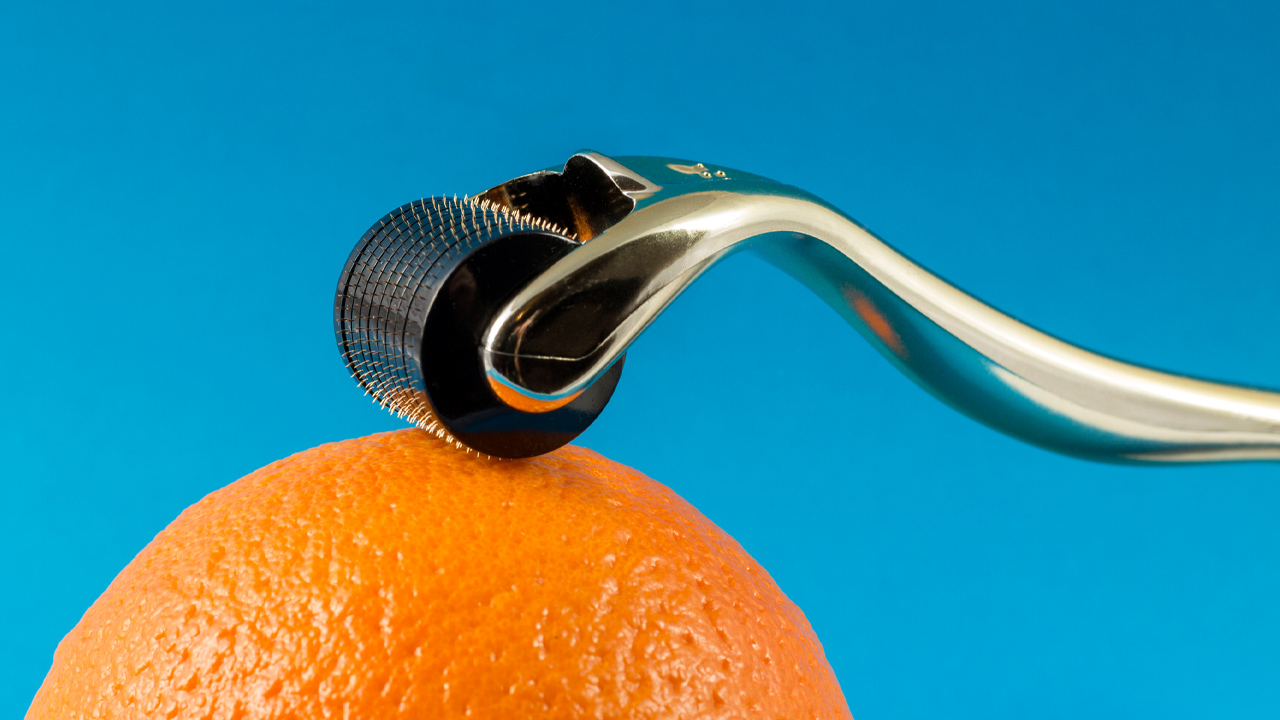Dermarolling 101: What to Consider Before Microneedling At Home
Read our guide before picking up that spiky little roller

While the prospect of rolling hundreds of tiny needles over your face sounds terrifying (not to mention painful), dermarolling is surprisingly pain-free and can do a lot of good for your skin. But before you start DIY microneedling, there are a few things to consider first. We went to some industry experts to find out about all things dermarolling, including what it does for your skin, how to properly dermaroll at home, the best tools for dermarolling and how to care for your skin afterwards to maximize results.
What is dermarolling?
“Dermarolling is generally performed at home using a handheld device fitted with a small roller that’s run up against the skin,” says Dr. Frances Jang, medical director and partner at Dermapure. She goes on to explain that the roller is embedded with 500-plus tiny needles, varying from 0.1mm to 0.5mm in length, and as the roller moves across the skin, the needles cause microtears. Thanks to these controlled injuries, the skin will heal itself and is left looking refreshed and plumped.
Are dermarolling and microneedling the same thing?
Dermarolling and microneedling (a.k.a. collagen induction therapy, or CIT) are similar in that they both aim to accomplish the same end goal in the skin, says Nikki Anderson, lead medical aesthetician and trainer at North Medical Spa in Toronto. Dermarolling is just one type of microneedling, and their results differ as dermarolling is a gentler option and is done at home whereas other forms of microneedling, like Dermastamping or Dermapen, are more aggressive treatments that are done in a physician’s office. “These are usually electrically driven and involve longer needles, which allow deeper penetration into the dermis, more consistent depth, more recovery time, more discomfort and therefore likely more results,” says Jang.
What are the benefits of microneedling?
According to Anderson, a microneedling sesh can lead to the production of collagen and elastin, and it can also improve scarring, pigmentation and the appearance of pores. “The benefits vary based on the settings chosen, the products used before, during and after the treatment and the knowledge and experience of the technician,” she says. Not only do microneedling and dermarolling kick-start collagen production but the microtears that occur during a sesh help enhance the penetration of skin serums, which in turn makes topical actives more effective, says Jang.
Does using a dermaroller hurt?
It all depends on how deep you’re going. Because at-home devices have smaller needles, it shouldn’t hurt, provided you’re doing it properly with the correct tool. For an in-office session, a numbing cream is applied prior to the treatment to help reduce pain. “There will likely be mere moments of discomfort, which will vary for each individual based on their pain threshold,” says Anderson.
How often should you dermaroll?
While there isn’t a set frequency with which you should dermaroll, as it depends on your skin, Jang says it’s acceptable to do it a couple of times a week, especially if you’re using a roller with shorter needles (0.1 to 0.3mm). With professional microneedling, Anderson recommends doing six sessions four to six weeks apart if you’re doing a corrective treatment for something like loss of volume or acne scarring. If the desired result is more preventative and to boost your glow, she says one treatment quarterly is ideal.
Who should use a dermaroller?
Dermarolling is used on a variety of skin types and ages, but Jang says that younger, thinner skin will likely reap more benefits from the treatment than older (think 50-plus), oilier and thicker skins. If you’re pregnant or have underlying skin conditions like eczema, rosacea or acne or your skin has had recent sun exposure, Anderson says that microneedling may not be suitable.
Is it safe to use a dermaroller?
Just because it can be done at home doesn’t mean there aren’t some important things to consider before you start rolling on the regular. Here are a few tips to get your best (and safest) DIY results:
Don’t forget to change your head
According to Jang, there’s a debate about how often your roller head should be replaced, with opinions varying from every 10 to 15 sessions to every six months. The answer depends on how often it’s used and which device you’re using, but it’s best to air on the side of caution. “It’s clear that the microneedles will dull over time, making treatments less effective and more painful,” says Jang, so keeping on top of your device is essential. Anderson recommends swapping in a new head every month if you’re doing regular treatments.
Keep your device sterile
We shudder to think of using a non-sanitized roller, as those germs would be pushed deep into your skin. Jang agrees. “DIY at-home dermarolling is not a sterile procedure, so there needs to be a mechanism to clean the device between uses,” she says. The devices in a professional office are single-use and disposable, but with multi-use home devices, hygiene is essential. To keep your head sterilized, Andersons recommends cleaning it with 70% isopropyl alcohol and storing it in a sanitary case.
Prep your skin
To ensure your skin is ready for a microneedling treatment, Anderson advises avoiding sun exposure, cosmetic injections and topical prescription acne treatments three weeks before sitting down with your roller.
How do you care for your skin after dermarolling?
Skin that is freshly dermarolled or microneedled is in a delicate state, so Jang advises staying clear of any irritating topicals such as retinols or physical or chemical exfoliants (think glycolic and other acids). Anderson explains that post-microneedling, your skin will likely be red and swollen and have a bumpy texture for three to five days. This is completely normal, but during this time you should avoid exercise, sun exposure and wearing makeup to ensure your skin heals properly. She also advises not using any skincare with fragrance, as that can irritate already sensitized skin. Give yourself a few days of staying in and taking it easy (hello, Netflix!), and keep your skin hydrated and protected with a mineral SPF as it won’t irritate compromised skin.
If you’re not sure how to best care for your skin post-treatment, discuss your concerns and needs with a board-certified dermatologist, who will be able to guide you with the proper post-treatment care.
What are some of the best tools for dermarolling?
With dermarollers being available in a wide variety of prices, there are a few things to check off your list before taking out your wallet. “Generally, the more expensive rollers use higher-quality materials and needles, and they tend to have a larger surface area,” explains Jang. More expensive doesn’t necessarily equal better, but you have to ensure that the quality is there before buying. Due to the DIY-ness of the treatment, safety is key, so opt for a tool from a verified retailer and make sure that it’s both well made and well reviewed.
Rodan + Fields Redefine Amp It Up Set, $452, rodanandfields.com
This kit has everything you need to start microneedling at home, including a dermaroller and five skincare products that will help boost your results.
BeautyBio GloPro Microneedling Facial Regeneration Tool, $249, sephora.ca
From one of the first brands to put dermarolling on the map, this award-winning set contains a roller equipped with LED red-light therapy to help stimulate cellular turnover and four skincare items to round out the treatment.
Environ Cosmetic Roll-CIT, $120, etiket.ca
This roller has needles that measure just 0.1mm for a gentle at-home rolling session and can be used on both the face and body.
StackedSkincare Microneedling Face Refining Tool, $125 USD, stackedskincare.com
Covered with 0.2mm stainless-steel needles, this roller is the perfect addition to a newbie roller’s skincare routine.
Zoe Ayla Professional Micro-Needling, $16, walmart.ca
Not sure if dermarolling is for you? This at-home tool lets you try the treatment without spending a fortune. It comes with a sanitary case and has needles that are 0.5mm long.








